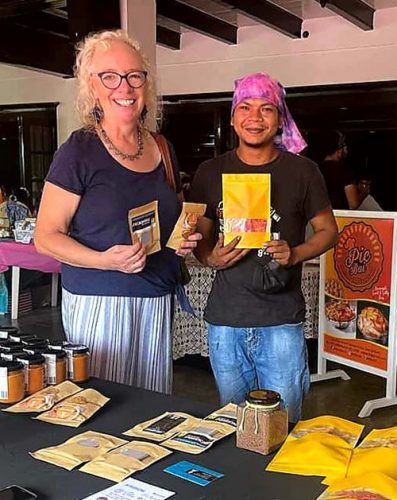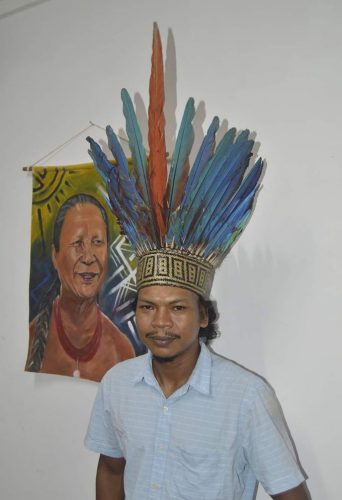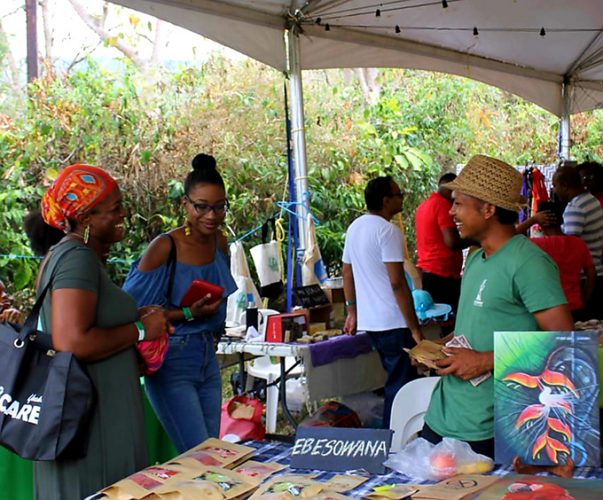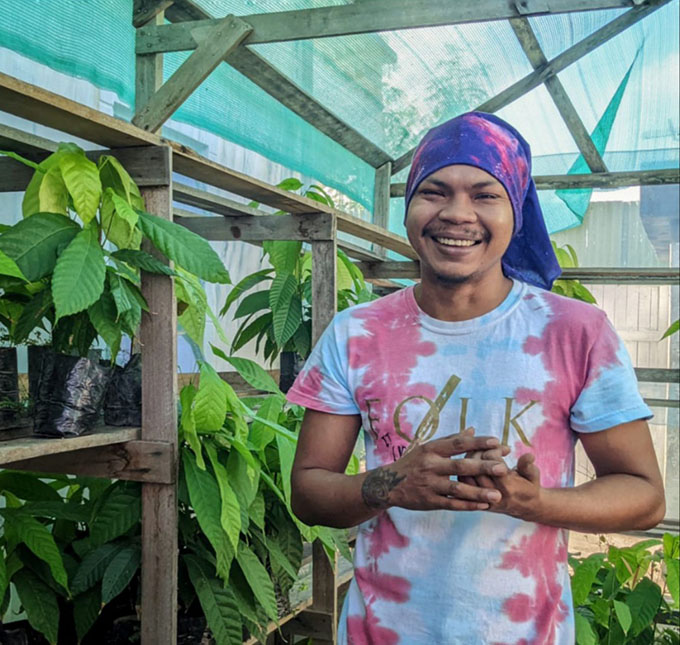At the New Fire Festival in Trinidad and Tobago in 2019, agro processor Andrew Campbell, 32, who was already involved in dehydrating local fruits for snacks, was encouraged to get involved in chocolate making by a Trinidadian social activist and chocolatier and so began his sojourn into the chocolate making cottage industry.
“I took my dried fruit products over there. During my time in Trinidad I met with Gillian Goddard, social activist and chocolatier, who gave me that push to see the value in the cocoa trees we have here. She not only encouraged but assisted in procuring a concher and a juicer for me and that was how I started with chocolate making in 2019.”

So he added chocolate to his Ebesowana brand business line, which included powdered ginger, dried water melon, dried pineapple, pepper powder infused with lemon or orange, turmeric powder, lime powder, thyme powder and dried thyme.
Ebesowana, a Lokono (Arawak) name, means transformation or change. “We need to change the way we think about our foods, especially those from the hinterland areas which are basically organic.”
Ebesowana takes orders for dried products from local and foreign clients and is a supplier of thyme powder to local manufacturer Ricks and Sari Agro Industries Ltd.
“My little chocolate cottage business could not have been possible without a lot of my Guyanese clients and supporters. Some people preordered bars of chocolate and paid upfront to sustain the business. Some reached out and donated US$100 or US$200 to what we were doing.”
Led by women’s rights activist Sherlina Nageer, Campbell said, “We raised over US$1,000 to buy a tempering machine. When I speak about we, it was those who supported the initiative from the inception.”
From a broader perspective, he said, employees, farmers, those involved in marketing and the wider community will benefit.
The high electricity rate and the inconsistency in the energy supply in Guyana, he said, drives the high price of his products. “If I am making chocolate and I use $44,000 in an energy bill to produce 1,000 bars on a monthly basis, in Trinidad they produce the same amount of bars for $14,000.”

Nevertheless, he says, “My chocolate is top notch compared to some produced by the best chocolate companies in the world.”
At the May 2022 Agricultural Investment Forum he gave out samples and was pleased that at least one European chocolatier said he could not remember tasting a better dark chocolate than Ebesowana’s.
Since he got into chocolate making, one of his concerns was getting an adequate supply of cocoa beans throughout the year. Initially, friends contributed US$275 to the seedlings project and Campbell developed some 1,000 seedlings, of which 400 were distributed to various farmers in the early phase free of cost.
He is currently preparing to develop 6,000 seedlings for sale, between July and December, at a cost of $50 each to cover soil, seedling bags and initial time spent caring for the plant.
“If you have land space, you can grow at least two or three cocoa tree in your yard and when you reap, I buy the beans.”
He usually scouts areas that were once known cocoa plantations. “I have from the 1750 and 1760 gene stock and I also get cocoa beans from Mabaruma, where I spent seven years as a teacher.”
He buys beans from Blue Flame Women’s Group, whose members he is assisting in moving from being producers of cocoa stick to making chocolate, chocolate bars and other products.
“My model is for everyone to benefit. It’s about building generational wealth for communities by encouraging individual farmers. In the long run I will definitely benefit.”
Campbell, who owns a small portion of land in Mabaruma, has already begun cultivating his land. However, he will need a larger quantity of cocoa beans for the export market.
Every two years, he noted, there is a cocoa excellence award that also recognises the quality of cocoa beans produced by farmers. “Based on the quality, you can submit and chocolatiers around the word can reach out to you to source cocoa. The type of seedlings I am developing, less than one percent of the beans is on the world market.”
He is currently working along with the National Agricultural Research and Extension Institute to identify the varieties of cocoa found locally. “A lot of farmers would reach out to me on social media, mainly Facebook, to request help. I have also made use of social media over the years to garner support for all the initiatives I have done.”
Noting that he sees a push by the government to revive the cocoa industry, Campbell said, “Government must acknowledge those of us in our homeland who are doing the groundwork with very little resources and support to those of us who need land instead of giving the land to foreigners to develop our idea and control it. We may not have the financial resources but we have the idea and the will to get the work done. I find it offensive that we have to be begging constantly for a little land to do farming.”
Born in Moruca sub-region, Campbell spent his early childhood with his grandparents Leandra and Cyril Campbell at St Peter’s Island in Santa Rosa Village. In 1997, he moved with them to Timehri, East Bank Demerara where he attended Timehri Primary.
“My grandparents had a serious impact on who I am today. They practiced their Indigenous way of life. They were simple, down to earth people who loved farming and were at one with the forest and nature. My grandfather had done surveying with his father in the 1950s and 1960s on the Guyana boundary line. Whenever I go to different hinterland locations and I do surveying, I see myself as following in his footsteps.”
Paying tribute
In September of 2000, Campbell joined his mother in Georgetown and completed his primary education at FE Pollard Primary. He went on to St John’s College and then to the University of Guyana (UG) on a Public Service Ministry scholarship in 2006 at 16 years. At UG, he obtained a Bachelor’s Degree in History with a minor in Tourism Studies.
“At UG, Ms Cecelia McAlmont, Dr Mellissa Ifill, Mr Clyde Thierens and the late Mr George Simon were lecturers who had tremendous impact on my thought process and the way I see the Guyanese society developing and how I can contribute.”
In his third year, Campbell “had serious challenges with youth development issues. I had a mental breakdown in my second semester during my third year. I wanted to quit. I walked out of the final exams of the philosophy course I was doing. I had done all the other work but it wasn’t sufficient to get a pass grade and it was a five-credit course. Mr Thierens called my phone for a few days. When I finally answered, he said, ‘Andrew I want you to complete the course. Come and write an essay for me. You may not get the grade you want but you won’t fail the course and you will be able to complete your final year. I wrote the essay and from there on I had a smooth final year under the guidance of Dr Ifill and Mr Thierens.”
Campbell met Simon during the second semester in his first year at a career fair. “I was in the art department. I didn’t know he was George Simon and we started a discussion on the Indigenous way of life and kanaima. After that we maintained contact and developed a friendship. There were times he asked me to speak on the Indigenous way of life to students who were doing the Amerindian Studies course.
I went with him on field trips and did excavations with him until his demise. At UG he became a father figure in my life. When I did a presentation on the development of local government in African Villages, I chose Beterverwagting. At the time he was living there and I stayed with his family for a month while I did my studies.
He gave me that access to a wider platform to basically enhance my knowledge, not only in art but in the Indigenous way of life and made me appreciate my Indigenous heritage.”
As an Indigenous person, growing up in Georgetown was never easy as Campbell faced prejudices and taunts because of his ancestry. “I tried to hide my identity because I didn’t want to clash with people over and over. Because I have small eyes many people called me ‘Chinee’ or ‘Chinee man’ and I had long hair so I could have easily hide my Indigenous identity. I tried to ease that pressure by being recognised as coming from a different ethnic background and being discriminated for who I am. After meeting George, I was able to identify myself as a strong Indigenous person and be proud of who I am. After January 2007, I was no longer afraid of being me and of having to deal with prejudices.”

Teaching
On graduating from UG in 2010, he sent out applications to several entities and after getting no response he went to the Ministry of Education to seek a teaching job. From the vacancies available, he chose North West Secondary in Mabaruma, Region One.
In November, 2010, on arrival in Mabaruma to start his first day of teaching, there was no housing accommodation. Neither the education department nor the regional administration were informed he was assigned to the school. On the recommendation of a friend, he stayed at Broomes Guest House for a year, which the regional administration paid for. He arrived in November and was not paid a salary until April 2011. During that time, with his mother’s help, he bought and sold ginger “to maintain” himself.
His accommodation in Mabaruma, he said, “was not nice. I was outspoken. I spoke about issues that were affecting me and the school. How children went to the back of the school to defecate and urinate because of inadequate toilet facilities. I told them that the school was preparing us for hell because it was so hot. Of course they don’t like people who speak about issues that affect everyone. I coped with it for seven years.”
He taught geography, history and social studies and the results in history and geography rose to 80 and 90 per cent passes by the time he left compared to the national pass rate of 60 and 70 per cent passes at the time.
“I think I did a fairly good job but wasn’t treated in a manner that reflected the work I did in the region. I worked with the athletic team and footballers. If you go through the national record you will see we moved from second to last to sixth place in 2016 in the Guyana Teachers Union national championships. Whenever they needed me to stayed in the dorms with the boys, I stayed.”
In July 2017 he left Mabaruma and the teaching profession and continued field excavations under Simon at intervals from July to October in Trinidad and Tobago at the Red House, which houses that country’s parliament. In 2011, 2012 and 2013, during the August holidays, Campbell was involved in archeological excavations with Simon in Guyana, including at the Dubulay ranch, where they discovered 5,000-year-old Terra Preta sites that indicated large populations lived there.
“George knew I was competent in doing field excavation and I am probably one of the best at it. So I was always invited to be part of his excavations teams that did excavations in Guyana and Trinidad and Tobago.”
In November, 2017, he went into beekeeping and in 2019 he continued work in Rewa Village and in the North Rupununi that included a survey of the petroglyphs at the Corona waterfall.
In 2019, on Dr Ifill’s recommendation Campbell applied and was successful in obtaining a US$2,000 grant funding from the Food and Agricultural Organisation to start an agro processing business.
“I experimented with dehydrated ginger and grinding ginger to powder. With the funds I bought a dehydrated package, including pans, trays and a grinder. After successful trials in September 2018 and after further research, I realized other fruits could be dried. I dried watermelon, pawpaw, mangoes, cashew, pineapple, soursop, sapodilla, guava and all Guyanese fruits as fruit snacks. Drying any fruit is one way you can add shelf life and value to it.”
“When I applied for the grant it was to add value to Guyanese raw produce by processing them into finished products, offering farmers a higher price for their produce, encouraging farmers to get into organic farming and to earn an income to support my education. I want to do a master’s degree and a PhD in archeology and I want to support the little projects I do in Indigenous communities without having to ask, as far as possible, government agencies or others to assist.”
In 2019, he launched Ebesowana products in the first Uncapped Exhibition hosted by the Guyana Manufacturing and Services Association.






